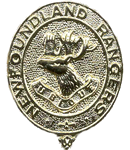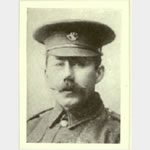Commemorated: | |||
| 1. Grave: | St. Sever Cemetery, Rouen | B.1.29 | |
| 2. Book: | The (1921) Masonic Roll of Honour 1914-1918 | Pg.121 | |
| 3. Memorial: | The (1940) Scroll - WW1 Roll of Honour | 13D GQS | |
Awards & Titles: | |||
Family :
A comprehensive account of Samuel Ebsary can be found here.Son of Newman and Sarah Ebsary, of 89, Southside, St. John's, Newfoundland.
Service Life:
Campaigns:
- The First World War 1914-1918, World-wide.
| Unit / Ship / Est.: 1/Newfoundland Regiment |
| Action : The Battles of the Somme 1916 |
The Battle of the Somme 1st July - 18th November 1916 is inevitably characterised by the appalling casualties (60,000) on the first day, July 1st 1916. Having failed to break through the German lines in force, and also failed to maximise opportunities where success was achieved, the battle became a series of attritional assaults on well defended defence in depth. The battle continued officially until 18th November 1916 costing almost 500,000 British casualties. German casualties were about the same, and French about 200,000. The Somme could not be counted a success in terms of ground gained or the cost, but it had a strategic impact as it marked the start of the decline of the German Army. Never again would it be as effective whilst the British Army, learning from its experience eventually grew stronger to become a war winning army. The German High Command recognised that it could never again fight another Somme, a view that advanced the decision to invoke unrestricted submarine warfare in an attempt to starve Britain of food and material, and in doing so accelerated the United States declaration of war thus guaranteeing the eventual outcome. 287 Brethren were killed on the Somme in 1916.
Detail :
2/Lieutenant Samuel Joseph EBSARY, 1st Battalion, Newfoundland Regiment.
Samuel Ebsary was one of the fortunate few who survived the destruction of the 1/Newfoundland battalion on the 1st July 1916 however his luck would not hold for too much longer. The losses sustained by the battalion on 1st July, and indeed by the whole of 29th Division, demanded a long period of recovery and retraining. Replacement drafts arrived and over a period of three months the battalion was brought back to normal strength. However by October the battalion was back on the Somme and was engaged in its second battle on the Somme, at Gueudecourt. The conditions that met the Newfoundlanders were those of a battle of attrition. The ground was churned by shells as the advance slowed and the same areas were attacked and counter attacked. Heavy rain at times rendered the trenches and ground impassable and created miserable conditions for the men on both sides. The 8th Brigade, of which the Newfoundland Regiment was part, was "loaned" to the 12th Division to assist in the Gueudecourt position. Heavy German shelling on 11th October 1916 caused heavy casualties as the battalion moved up for the attack which went in the following day. The battalion advanced in two waves, each on a front of two platoons, covered by a creeping barrage of machine guns which successfully kept place with the advancing troops. The battalion entered Rainbow Trench but had to fight every foot against a very determined enemy before taking Hilt Trench. Eventually the Newfoundlanders took not only their objective but also part of that of the 1/Essex to their left and moved forward to take Grease Trench. (To their left the 7/Norfolks were less successful ? see ABBOTT, John Joseph, Sergeant, 7/Norfolks)
Samuel EBSARY was wounded in the attack on the 12th October and two days later was admitted to the 8th General Hospital in Rouen where he died of wounds on 15th October 1916. He was one of the ?First Five Hundred? to join the regiment in September 1914 and by October 1914 had shown the necessary leadership qualities to be promoted to Company Sergeant Major. He served in Gallipoli where he was promoted to Acting Regimental Sergeant Major before being evacuated sick from Suvla Bay on the 2nd December 1915. Following his recovery he rejoined the battalion in France and following the dreadful officer casualties sustained in the 1st July on the Somme he was promoted to 2/Lieutenant. The following extract from Colonel Nicholson's book The Newfoundlander: ?It was nearly midnight when 2nd Lieutenant Sam Ebsary dropped out of the darkness near the entrance to re-appear with a large accordion which he had brought with him from 'A' Company's billets in the ramparts. Let one of 'D' Company's officers who was present describe the scene: ?Sitting in the corner on an empty ammunition box, he commenced to play and as the music emerged from the instrument, the sand-bagged walls of our 'H.Q.' seemed to fade; The Banks of Newfoundland rang in our ears and we saw once more the tented slopes of Quidi Vidi on Regatta Day; the Blue Peter had turned the buoy and the other boats were swinging into position?. His career will certainly endorse my assessment of him. He was a dynamic and polished athlete, a man respected and admired by his brothers in arms? He was initiated into AVALON Lodge No 776 on 9th May 1912, was Passed on 11th July and Raised on 16th September 1912. His occupation was a Store Keeper. During the attack on the 12th October he advanced with Brother Lieutenant Cecil Bayly CLIFT of WHITEWAY Lodge No 3541 who unfortunately was killed in action.
Samuel Ebsary was a noted oarsman and was inducted into the St. John's Regatta Hall of Fame. From 1908 to 1913, as the official records of Regatta participation reveal, Ebsary was the premier coxswain on the pond. By then he had actively participated in each and every annual Regatta over that period. In all, he took part in 71 races either as a coxswain or an oarsman. Over that span he had 34 first place finishes; he finished in second place 22 times, placed third on 8 occasions, and finished out of the money in fourth place 7 times. The record shows that he was earlier a member of the 1899 Church Lads Brigade boat which has some connection to the Newfoundland Regiment when it was raised some years later. The Church Lads Brigade wore a blue uniform and whilst the regiment was awaiting its khaki uniforms it wore CLB blue uniforms, hence it acquired its nickname 'The Blue Puttees'. The large numbers of men associated with the CLB represented the core of the initial volunteers for the Newfoundland Regiment, and no doubt Samuel Ebsary was one of them. A farewell gathering of masons took place in the Temple in St. John's on September 30, 1914 to bid farewell to the brethren going in the First Contingent to England. A similar event took place in 1915 when the brethren were presented with a special form of prayer to be used during the war. The brethren of all Lodges in Newfoundland contributed to the establishment of the Newfoundland Freemasons Ward of ten cots in a hospital in Southern England. Joseph Ebsary's father Newman Ebsary resided at 89 Southside Rd in St John's and he was a marine engineer by trade. All five of Newman Ebsary's sons and his son-in-law signed up when volunteers were called for during World War 1. Albert and William did not go overseas. Albert was a cook on the ships that took the men overseas during the war. William was a cook at the convalescent hospitals in St John's. Young Fred died of meningitis in Egypt, Joseph Hollahan was killed in action July 1, 1916. Every July 1st, until he died in 1941, Newman Ebsary climbed the hill behind his house and flew Samuel's flag at half mast.
Sources Official History Military Operations France & Belgium 1916 Vol II Newfoundland Grand Banks website; http://ngb.chebucto.org/NFREG/WWI/ww1-add-ebsarybros.shtml History of St John?s Lodge No 1; http://www.historyofsaintjohnslodgeno1.blogspot.com/ The First Five Hundred-Cramm
Masonic :
| Type | Lodge Name and No. | Province/District : |
|---|---|---|
| Mother : | Avalon Lodge No. 776 E.C. | Newfoundland |
Initiated | Passed | Raised |
9th May 1912 | 11th July 1912 | 16th September 1912 |
Source :
The project globally acknowledges the following as sources of information for research across the whole database:
- The Commonwealth War Graves Commission
- The (UK) National Archives
- Ancestry.co.uk - Genealogy, Family Trees & Family History online
- ugle.org.uk - The records of the United Grand Lodge of England including the Library and Museum of Freemasonry
Additional Source:
- Founder Researchers : Paul Masters & Mike McCarthy
- Researcher : Bruce Littley

